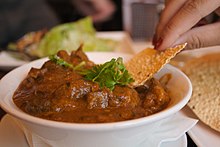Rogan Josh

Rogan josh , also roghan josh , pronounced in Persian / rouɣændʒuːʃ / , is a strongly seasoned lamb dish of Persian origin and one of the traditional dishes of Kashmiri cuisine . Roughan ( روغن) means "clarified butter" or "fat" in Persian , while juš (جوش) (romanized josh ), which has the meaning "intensity" or "passion" and is ultimately derived from the verb jušidan (جوشيدن) with the meaning "heat or boil". Rogan josh means, loosely translated, "cooking with great heat in oil". Another interpretation leads rogan josh back to the words rogan "red color" (with the same Indo-European root as French "rouge", Spanish "rojo") and josh "passion" or "heat".
Rogan josh became popular in Kashmir among the Mughal rulers, who in turn were heavily influenced by Persian cuisine . The summer heat of the Indian lowlands meant that the Mughal rulers often retreated to Kashmir , where the climate is cooler due to the high altitude and latitude.
Ingredients and geographical distribution
Rogan josh is one of the staple dishes in Kashmiri cuisine. There it was established by the Mughal rulers. It is one of the main courses on the Wazwan , a multi-course fixed menu . The main ingredients of rogan josh are pieces of braised lamb in a sauce based on roasted onions or shallots, yogurt, garlic, ginger and spices (cloves, bay leaves, cardamom and cinnamon). The rogan josh gets its characteristic red color from the addition of large quantities of dried chilli peppers from cashmere, the seeds of which are removed before use to reduce the heat . These chillies (the taste of which is roughly the same as that of paprika) are considerably milder than the cayenne pepper that is otherwise common in Indian cuisine .
The spiciness of the dish has more of an effect on the smell than on the sharpness, so that the rogan josh is also suitable for the European taste that is not used to the excessive use of chilli. In some variants of the dish, the dried roots or flowers of the make-up root are also used to give the dish a purple color. Also saffron threads are sometimes used in some traditional varieties.
There are significant differences between the preparation according to the Hindu and Muslim tradition in Kashmir: While the Muslims praan , a local type of shallot with a strong garlic flavor , and mayal , the leaves of Celosia Cristata , a variant of the pork fire , for the color and to soften the pungent taste add, Hindus use neither one nor the other. In contrast to the rest of India, Kashmiri Brahmins eat meat, but like them (traditionally) avoid garlic and onions and mix yoghurt with the rogan josh to achieve a cooling effect.
Although the dish comes from Jammu and Kashmir , it is part of the basic menu of British curry restaurants, whose menu consists largely of dishes from Bangladesh , and is a prime example of the adoption and adaptation of dishes from the former British colonial area.
Europeanized variants
While traditional variants use whole dried chilli , which have been cored and ground to a paste after soaking in water, the European variants mainly use Kashmiri chilli powder or mixtures of paprika powder and cayenne pepper.
Another variant that is also popular in British restaurants uses green and black cardamom as well as bay leaves and aniseed.
Although this is not used everywhere, many western variants of the dish use tomatoes, which thin the sauce a little and intensify the taste and the red color. This is particularly the case with the numerous ready-made sauces.
In India, rogan josh is often prepared with goat meat instead of lamb because it is much more readily available. There is also a variant with beef, where the brisket is preferred.
Individual evidence
- ↑ a b c Lizzie Collingham: Curry: A Tale of Cooks and Conquerors . Oxford UP, February 6, 2006, ISBN 9780199883813 , p. 34 (Retrieved August 8, 2013).
- ^ A b Camellia Panjabi: The Great Curries of India . Simon & Schuster, 1995, ISBN 9780684803838 , p. 54 (accessed August 8, 2013).
- ^ Jo Monroe: Star of India: The Spicy Adventures of Curry . John Wiley & Sons, 2005, ISBN 9780470091883 , p. 131 (Retrieved August 8, 2013).
- ↑ Recipe Source: Rogan Josh - Madhur Jaffrey
- ^ Sanjeev Kapoor: How to Cook Indian: More Than 500 Classic Recipes for the Modern Kitchen . Stewart, Tabori & Chang, 2011, ISBN 9781613121351 , p. 39 (accessed August 8, 2013).
- ↑ Sri Owen: The Rice Book: The Definitive Book on Rice, with Hundreds of Exotic Recipes from Around the World . St. Martin's Press, 1994, ISBN 9780312303396 , p. 275 (accessed August 8, 2013).